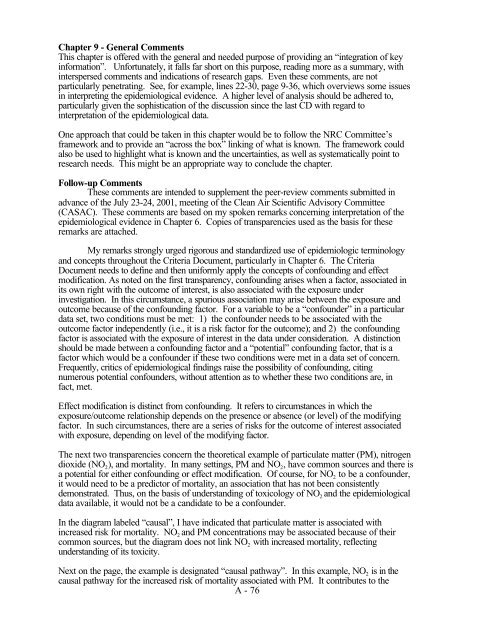Review of the Air Quality Criteria Document for Particulate Matter
Review of the Air Quality Criteria Document for Particulate Matter
Review of the Air Quality Criteria Document for Particulate Matter
- No tags were found...
Create successful ePaper yourself
Turn your PDF publications into a flip-book with our unique Google optimized e-Paper software.
Chapter 9 - General CommentsThis chapter is <strong>of</strong>fered with <strong>the</strong> general and needed purpose <strong>of</strong> providing an “integration <strong>of</strong> keyin<strong>for</strong>mation”. Un<strong>for</strong>tunately, it falls far short on this purpose, reading more as a summary, withinterspersed comments and indications <strong>of</strong> research gaps. Even <strong>the</strong>se comments, are notparticularly penetrating. See, <strong>for</strong> example, lines 22-30, page 9-36, which overviews some issuesin interpreting <strong>the</strong> epidemiological evidence. A higher level <strong>of</strong> analysis should be adhered to,particularly given <strong>the</strong> sophistication <strong>of</strong> <strong>the</strong> discussion since <strong>the</strong> last CD with regard tointerpretation <strong>of</strong> <strong>the</strong> epidemiological data.One approach that could be taken in this chapter would be to follow <strong>the</strong> NRC Committee’sframework and to provide an “across <strong>the</strong> box” linking <strong>of</strong> what is known. The framework couldalso be used to highlight what is known and <strong>the</strong> uncertainties, as well as systematically point toresearch needs. This might be an appropriate way to conclude <strong>the</strong> chapter.Follow-up CommentsThese comments are intended to supplement <strong>the</strong> peer-review comments submitted inadvance <strong>of</strong> <strong>the</strong> July 23-24, 2001, meeting <strong>of</strong> <strong>the</strong> Clean <strong>Air</strong> Scientific Advisory Committee(CASAC). These comments are based on my spoken remarks concerning interpretation <strong>of</strong> <strong>the</strong>epidemiological evidence in Chapter 6. Copies <strong>of</strong> transparencies used as <strong>the</strong> basis <strong>for</strong> <strong>the</strong>seremarks are attached.My remarks strongly urged rigorous and standardized use <strong>of</strong> epidemiologic terminologyand concepts throughout <strong>the</strong> <strong>Criteria</strong> <strong>Document</strong>, particularly in Chapter 6. The <strong>Criteria</strong><strong>Document</strong> needs to define and <strong>the</strong>n uni<strong>for</strong>mly apply <strong>the</strong> concepts <strong>of</strong> confounding and effectmodification. As noted on <strong>the</strong> first transparency, confounding arises when a factor, associated inits own right with <strong>the</strong> outcome <strong>of</strong> interest, is also associated with <strong>the</strong> exposure underinvestigation. In this circumstance, a spurious association may arise between <strong>the</strong> exposure andoutcome because <strong>of</strong> <strong>the</strong> confounding factor. For a variable to be a “confounder” in a particulardata set, two conditions must be met: 1) <strong>the</strong> confounder needs to be associated with <strong>the</strong>outcome factor independently (i.e., it is a risk factor <strong>for</strong> <strong>the</strong> outcome); and 2) <strong>the</strong> confoundingfactor is associated with <strong>the</strong> exposure <strong>of</strong> interest in <strong>the</strong> data under consideration. A distinctionshould be made between a confounding factor and a “potential” confounding factor, that is afactor which would be a confounder if <strong>the</strong>se two conditions were met in a data set <strong>of</strong> concern.Frequently, critics <strong>of</strong> epidemiological findings raise <strong>the</strong> possibility <strong>of</strong> confounding, citingnumerous potential confounders, without attention as to whe<strong>the</strong>r <strong>the</strong>se two conditions are, infact, met.Effect modification is distinct from confounding. It refers to circumstances in which <strong>the</strong>exposure/outcome relationship depends on <strong>the</strong> presence or absence (or level) <strong>of</strong> <strong>the</strong> modifyingfactor. In such circumstances, <strong>the</strong>re are a series <strong>of</strong> risks <strong>for</strong> <strong>the</strong> outcome <strong>of</strong> interest associatedwith exposure, depending on level <strong>of</strong> <strong>the</strong> modifying factor.The next two transparencies concern <strong>the</strong> <strong>the</strong>oretical example <strong>of</strong> particulate matter (PM), nitrogendioxide (NO 2 ), and mortality. In many settings, PM and NO 2 , have common sources and <strong>the</strong>re isa potential <strong>for</strong> ei<strong>the</strong>r confounding or effect modification. Of course, <strong>for</strong> NO 2 to be a confounder,it would need to be a predictor <strong>of</strong> mortality, an association that has not been consistentlydemonstrated. Thus, on <strong>the</strong> basis <strong>of</strong> understanding <strong>of</strong> toxicology <strong>of</strong> NO 2 and <strong>the</strong> epidemiologicaldata available, it would not be a candidate to be a confounder.In <strong>the</strong> diagram labeled “causal”, I have indicated that particulate matter is associated withincreased risk <strong>for</strong> mortality. NO 2 and PM concentrations may be associated because <strong>of</strong> <strong>the</strong>ircommon sources, but <strong>the</strong> diagram does not link NO 2 with increased mortality, reflectingunderstanding <strong>of</strong> its toxicity.Next on <strong>the</strong> page, <strong>the</strong> example is designated “causal pathway”. In this example, NO 2 is in <strong>the</strong>causal pathway <strong>for</strong> <strong>the</strong> increased risk <strong>of</strong> mortality associated with PM. It contributes to <strong>the</strong>A - 76
















